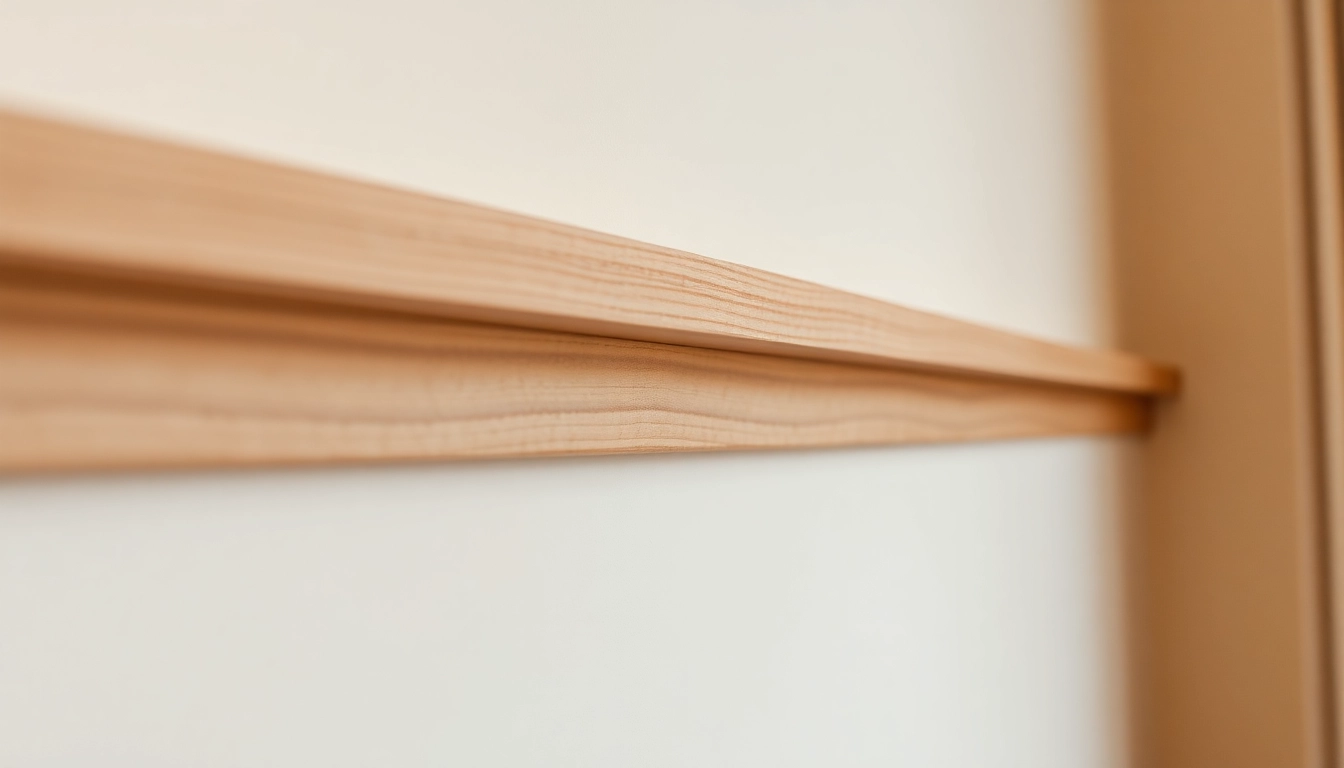Understanding Finish Trim: Types and Styles
Finish trim is a fundamental element of interior design that elevates the aesthetics of any space. It acts as the finishing touch that transitions walls to floors, frames doors and windows, and adds architectural detail that reflects personal style. Whether you’re completing a new build, renovating an existing room, or enhancing the character of a space, selecting the right finish trim is crucial for achieving a polished look. To ensure your project’s success, it’s important to understand the diverse types and styles of finish trim available today. Finish trim options vary widely, offering choices that cater to both functional and decorative goals.
Common Types of Finish Trim Used in Homes
Finish trim encompasses a variety of moldings and moldings profiles, each serving specific architectural roles. Some of the most popular types include:
- Baseboards: Installed along the bottom of walls, baseboards hide uneven wall-floor joints and protect walls from damage. They come in various heights, thicknesses, and profiles, ranging from simple to ornate designs.
- Crown Molding: Positioned at the junction between walls and ceilings, crown molding creates a seamless transition that adds elegance and height to a room. It’s available in a multitude of styles, from classic to contemporary.
- Door and Window Casing: These moldings frame openings, providing a clean transition between the wall and the door or window frame. Casings can be simple flat boards or intricate profiles with decorative details.
- Wainscoting and Chair Rail: Wainscoting panels add decorative detail to lower walls, often combined with chair rails, which run horizontally at chair height, protecting walls and enhancing visual appeal.
- Quarter Round and Shoe Molding: Usually used at the base of baseboards, these small moldings cover any gaps and provide a smooth transition from trim to flooring.
Each type of finish trim can be customized in size and profile, enabling tailored solutions that match your desired aesthetic and functional needs.
For a comprehensive selection of finished moldings, online resources like The Home Depot and Lowes offer extensive catalogs to explore.
Popular Styles and Profiles for Interior Finish Trim
Styles and profiles define the visual impact of finish trim, influencing the overall decor theme. Some of the most prevalent styles include:
- Flat and Simple Profiles: Minimalist by nature, these trims feature clean lines and smooth surfaces, perfect for modern or contemporary interiors.
- Beaded and Ridged Profiles: These include decorative beads or grooves that add subtle texture and visual interest, often found in traditional or transitional designs.
- Ogee and Curved Profiles: Characterized by ornate curves, these styles are typical in classical and Victorian interiors, lending an air of sophistication.
- Deep-Profile Mouldings: With prominent dimensions and intricate patterns, these are often used in formal settings or for statement architecture.
Choosing the right profile involves considering both aesthetic harmony with your interior design and functional compatibility with the space. For instance, taller ceilings may accommodate more elaborate crown moldings, while a modern, minimalist interior benefits from simple, unobtrusive trim.
Examining detail profiles and understanding the style language can significantly influence the perceived size and style of your space. Websites dedicated to trim and molding styles, such as The Brownstone Boys, provide valuable visual guides and tutorials.
Choosing the Right Finish Trim for Your Design
Selecting finish trim that aligns with your interior design requires a thoughtful approach—considering stylistic coherence, material compatibility, and your project’s practical needs. Here are key factors to consider:
- Design Style: Modern interiors often favor flat, sleek profiles with minimal ornamentation. Traditional and Victorian styles, on the other hand, embrace intricate profiles like ogee, fluted, or carved moldings.
- Room Function and Traffic: High-traffic areas or spaces prone to damage—such as kitchens and hallways—may require durable materials and simpler profiles for ease of maintenance.
- Ceiling Height: Taller ceilings allow for more elaborate crown moldings and taller baseboards, creating a grander aesthetic.
- Material Compatibility: Choose materials that complement other elements such as flooring, cabinetry, and wall treatments. For example, rich woods may suit traditional decor, while MDF or PVC are suitable for budget-conscious or humid environments.
- Color and Finish: Finish trim can be painted, stained, or left natural. Painted trim offers versatility in matching or contrasting wall colors, while stained wood highlights natural grains.
For personalized advice, consulting a professional remodeler or interior designer can be invaluable. They can recommend tailored solutions, considering your space’s unique characteristics and your aesthetic vision.
Step-by-Step Installation of Finish Trim
Preparing Surfaces and Measuring Accurately
The foundation of a professional-looking finish trim project lies in meticulous preparation. Begin by preparing your surfaces—ensure walls and studs are smooth, clean, and free of debris. This guarantees optimal adhesion and a flawless finish.
Accurate measurement is critical — errors here often lead to gaps, misalignments, and an unprofessional appearance. Use a high-quality tape measure and a combination square, and always double-check measurements before cutting. Mark your cut lines clearly with a pencil, and consider using a cutting guide for straight, consistent cuts.
For complex cuts, especially at corners and around obstacles like outlets or window casings, precise measurements and templates help in achieving a tight fit and seamless joints.
Cutting and Fitting Finish Trim for a Precise Fit
Cutting finish trim accurately requires appropriate tools—saws such as a miter saw, chop saw, or even a hand saw with a miter box are suitable options. When cutting corners, inside and outside, precise angled cuts (commonly 45 degrees) are essential for clean joints.
Test fit each piece before fixing to identify any discrepancies. Adjustments can be made with a file or sanding block to refine fit, especially at miters or corners. When fitting crown molding at an angle, use a level to coordinate the correct pitch, ensuring level or plumb alignment once installed.
Securing and Finishing Trim for a Flawless Look
Fasten finish trim using finishing nails or brads, ideally with an air compressor or nail gun for efficiency. Countersink the nails slightly below the surface, then fill the holes with wood filler or caulk. Sand smooth to prepare for finishing.
Seal the joints with high-quality caulk—preferably paintable and flexible—to bridge gaps and create a seamless transition. Once the filler and caulk dry, sand lightly for a smooth surface, then proceed to painting or staining.
For a high-end finish, consider applying a primer before painting, and use high-quality paint or stain suitable for your trim material. A consistent coat without drips or brush marks is key to a professional appearance.
Materials and Finish Options for Superior Results
Wood, MDF, and Composite Materials
The choice of material heavily influences the appearance, durability, and ease of installation of finish trim. Traditional wood trim, such as pine, oak, or poplar, offers rich aesthetics and can be stained or painted. However, it requires more maintenance and is susceptible to moisture damage.
Medium-density fiberboard (MDF) and composite trims present economical, stable alternatives that are easy to work with and resistant to warping. They come pre-primed and are ideal for painted finishes, especially in humid environments.
Modern innovations include PVC and fiber-reinforced composites designed for exterior applications but increasingly popular for interior use due to their durability and low maintenance.
Paints, Stains, and Clear Finishes to Enhance Appearance
The aesthetic and protective qualities of finish trim depend greatly on your choice of finish. Paints are the most versatile, available in countless colors and sheens—from matte to gloss. For trim in high-use areas, semi-gloss or gloss paints provide durability and ease of cleaning.
Stains showcase natural wood grain, suitable for traditional or rustic decor. Clear finishes, such as polyurethane or lacquer, offer varnished protection while preserving the wood’s natural beauty.
For a premium appearance, consider using high-end paints like Benjamin Moore Aura interior latex, which provides excellent coverage, smooth finish, and longevity. Properly applied, finishes can significantly enhance the perceived quality of your installation.
Durability and Maintenance of Different Finish Trim Materials
Understanding the maintenance requirements of various materials is key to ensuring your finished trim remains in pristine condition. Wooden trim, when properly sealed and painted, can last decades but may require periodic touch-ups due to scratches or moisture exposure.
Manufactured materials like MDF or PVC are low-maintenance, resistant to pests, rot, and moisture, making them suitable for bathrooms or kitchens. Cleaning generally involves mild soap and water, avoiding abrasive cleaners that can damage the finish.
Regular inspection and prompt repair of scratches or paint chips help extend the lifespan of your finish trim, preserving both its aesthetic appeal and functional integrity.
Best Practices for Achieving a High-Quality Finish
Preparation Tips for Smooth Surfaces
Achieving a flawless finish starts with surface preparation. Sand all surfaces to remove splinters, roughness, or old paint. Use fine-grit sandpaper (220 grit) for the final pass. Clean dust thoroughly to prevent blemishes under coat.
Ensure that all joints are tight, and any gaps are filled with caulk or wood filler. Proper preparation minimizes the need for extensive touch-ups and ensures smooth paint or stain application.
Painting and Sealing Techniques for a Seamless Look
The application process impacts the overall quality of your finish. Use quality brushes and rollers suitable for your paint type. Apply a primer first to ensure adhesion and uniform color—especially important on raw or uneven surfaces.
Multiple thin coats yield a better finish than a single thick coat. Allow each coat to dry thoroughly and lightly sand between coats to eliminate imperfections. For crown molding and intricate profiles, a brush along the edges ensures complete coverage.
Seal joints with a high-quality, paintable caulk for a seamless appearance. Once finished, wiping the trim with a clean cloth enhances the sheen and eliminates dust.
Common Mistakes to Avoid in Finish Trim Projects
Even experienced DIYers can make errors that compromise the final look. Common pitfalls include inconsistent measurements leading to gaps, rushing the painting process resulting in drips, or neglecting surface preparation.
Avoid using low-quality materials or inadequate fasteners, which can cause warping or loosening over time. Not properly filling or sanding holes diminishes the professional appearance. Lastly, ignoring humidity and temperature conditions during installation or finishing can cause paint failure or warping.
Careful planning, patience, and adherence to best practices help ensure your project’s success and durability.
Transforming Spaces with Finish Trim: Inspiration & Trends
Modern and Minimalist Finish Trim Ideas
Contemporary design favors clean lines, recessed or flat trim profiles, and monochromatic color schemes. Flat casing and simple baseboards, painted in matching or contrasting shades, can create a sleek, uncluttered look. Minimalist crown moldings or even absence thereof contribute to an open, airy feel.
Innovative materials like PVC or composite with smooth finishes suit this aesthetic, often combined with hidden fasteners or no-miter joints for a seamless appearance.
Traditional and Ornamental Finish Trim Styles
In contrast, traditional interiors celebrate ornate, detailed moldings with intricate carvings, plant motifs, and layered profiles. Crown moldings with scrollwork, elaborate pediments, and wainscoting with decorative panels evoke historical elegance and craftsmanship.
Color schemes often involve rich hues and glossy finishes that enhance the detailing. The goal here is to evoke timelessness and grandeur, often seen in Victorian, Colonial, or Classical decor.
Incorporating Finish Trim into Renovation Projects
Finish trim can dramatically-transform a space by defining character, adding visual interest, and framing architectural features. During renovations, consider upgrading existing trim to more elaborate profiles or adding decorative elements like window casings or chair rails.
Matching trim styles across adjacent rooms creates visual harmony, while mixing profiles can add eclectic appeal. Strategic placement of trim can also highlight architectural features such as high ceilings, large windows, or custom cabinetry.
Incorporating new finish trim is an accessible, cost-effective way to enhance aesthetics and perceived value of your home, making it an essential consideration for both DIYers and professionals.




